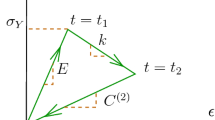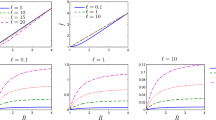Abstract
In Part I, an implicit constitutive relation was proposed to describe stress softening of solids. In this second part, we use the constitutive relation developed earlier to study different boundary value problems, namely the homogeneous compression of a cylinder without radial stresses, the homogeneous compression of a cylinder with radial stress (triaxial test), the simple shear of a slab, and the inflation of a cylindrical annulus, when the displacement gradients are small.



Similar content being viewed by others
Notes
Here, \(\pmb {{\mathscr {A}}}\) and \(\pmb {{\mathscr {B}}}\) are fourth-order tensor functions that can depend on \({\mathbf {S}}\) and \({\mathbf {E}}\).
The inner product is denoted by : , and for two second-order tensors \({\mathbf {A}}\), \({\mathbf {B}}\), we have that \({\mathbf {A}}:{\mathbf {B}}\) becomes in index notation and Cartesian coordinates \(A_{ij}B_{ij}\). If \(\pmb {{\mathscr {A}}}\) is a fourth-order tensor, \(\pmb {{\mathscr {A}}}:{\mathbf {A}}\) becomes \({\mathscr {A}}_{ijkl}A_{kl}\). For two fourth-order tensors \(\pmb {{\mathscr {A}}}\) and \(\pmb {{\mathscr {B}}}\), we have that \(\pmb {{\mathscr {A}}}:\pmb {{\mathscr {B}}}\) is equivalent to \({\mathscr {A}}_{ijkl}{\mathscr {B}}_{klmn}\).
References
Rajagopal, K.R.: On implicit constitutive theories. Appl. Math. 48, 279–319 (2003)
Rajagopal, K.R.: The elasticity of elasticity. Z. für Angew. Math. Phys. 58, 309–317 (2007)
Rajagopal, K.R., Srinivasa, A.R.: On the response of non-dissipative solids. Proc. R. Soc. A 463, 357–367 (2007)
Rajagopal, K.R., Srinivasa, A.R.: On a class of non-dissipative solids that are not hyperelastic. Proc. R. Soc. A 465, 493–500 (2009)
Rajagopal, K.R.: On a new class of models in elasticity. Math. Comput. Appl. 15, 506–528 (2010)
Rajagopal, K.R.: Conspectus of concepts of elasticity. Math. Mech. Solids 16, 536–562 (2011)
Rajagopal, K.R., Srinivasa, A.R.: Inelastic response of solids described by implicit constitutive relations with nonlinear small strain elastic response. Int. J. Plast. 71, 1–9 (2015)
Rajagopal, K.R., Srinivasa, A.R.: An implicit three-dimensional model for describing the inelastic response of solids undergoing finite deformation. Z. Angew. Math. Phys. 67, 6 (2016)
Saravanan, U., Rajagopal, K.R., Tom, R.M., Bahradwaj, K.: A model for a solid undergoing rate-independent dissipative mechanical processes. Math. Mech. Solids 26, 230–243 (2020)
Cichra, D., Průs̆a, V.: A termodynamic basis for implicit rate-type constitutive relations describing the inelastic response of solids undergoing finite deformation. Math. Mech. Solids 25, 2222–2230 (2020)
Bustamante, R., Rajagopal, K.R.: A review of implicit constitutive theories to describe the response of elastic bodies. Constitutive Modelling of Solid Continua (Merodio, J., Ogden, R., eds.) Springer International Publishing, Cham, Switzerland 187–230 (2020)
Bustamante, R., Rajagopal, K.R.: A three-dimensional implicit constitutive relation for a body exhibiting stress softening. Part I: Theoretical underpinning. Acta Mech. (Accepted)
Truesdell, C.A., Toupin, R.: The classical field theories. In: Handbuch der Physik, Vol.III/1. Berlin, Germany: Springer, (1960)
Jog, C.S.: The explicit determination of the logarithm of a tensor and its derivatives. J. Elast. 93, 141–148 (2008)
Monchiet, V., Bonnet, G.: Inversion of higher order isotropic tensors with minor symmetries and solution of higher order heterogeneity problems. Proc. R. Soc. A 467, 314–332 (2011)
Acknowledgements
R. Bustamante would like to express his gratitude for the financial support provided by FONDECYT (Chile) under grant no. 1210002. K. R. Rajagopal thanks the National Science Foundation and the Office of Naval Research for support of this work.
Author information
Authors and Affiliations
Corresponding author
Additional information
Publisher's Note
Springer Nature remains neutral with regard to jurisdictional claims in published maps and institutional affiliations.
Appendices
Appendix A: Analysis of the implicit relation for 1D problems
In this Section, we study briefly a 1D counterpart of (12), (13) and compare that with the models presented in Appendix A of [12]. In that Appendix, we use the notation \(\epsilon \), \(\sigma \) for the 1D counterpart of the strain and stress tensors, \({\bar{D}}\) and D are the 1D counterpart of the tensors \(\bar{{\mathbf {D}}}\) and \({\mathbf {D}}\), respectively, then (12) becomes:
where the counterpart of (13) is
The above equations can be compared with the results presented in Appendix A of [12].
Appendix B: A semi-analytical method to solve the boundary value problem for the annulus with radial traction on its inner surface
In this Appendix, we explore a numerical method to solve (121) for the case of the inflation of a cylindrical annulus, when there is stress-softening for a part of the annulus.
We assume that the functions \({\bar{D}}_r^{(1)}(r)\), \({\bar{D}}_\theta ^{(1)}(r)\), and \({\bar{D}}_z^{(1)}(r)\) in (121) are given by a Taylor series:
and we assume a similar approximate solution for \({^{\mathrm {(b)}}}{\sigma }_r\) as
In general, it is not necessary that \(N_r\), \(N_\theta \), \(N_z\), and \(N_\sigma \) are the same.
One way to solve the boundary value problem is described now:
-
In the case of (115.1) from the boundary condition \({^{\mathrm {(a)}}}{\sigma }_r(r_\mathrm {o},t)=0\), we obtain
$$\begin{aligned} {^{\mathrm {(a)}}}{C}_2(t)=\frac{{^{\mathrm {(a)}}}{C}_1(t)}{2r_\mathrm {o}^2}. \end{aligned}$$(126) -
From the boundary condition \({^{\mathrm {(b)}}}{\sigma }_r(r_\mathrm {i},t)=-P(t)\) and (125), we obtain
$$\begin{aligned} \phi _0(t)=-P(t). \end{aligned}$$(127) -
Using (124) and (125) in (121) after some manipulations, which for brevity are not shown here, we obtain the polynomial equation
$$\begin{aligned} \vartheta _0+\vartheta _1r+\vartheta _2r^2+\vartheta _3r^3+\cdots \vartheta _Mr^M=0, \end{aligned}$$(128)where \(\vartheta _m\) are functions that depend on the constants \(b_1\), \(b_2\), \(\alpha _n\), \(\beta _n\), \(\gamma _n\), \(\epsilon _o\) and the functions \(\lambda (t)\), P(t), and \(\phi _1(t)\), \(\phi _2(t)\),...,\(\phi _{N_\sigma }(t)\). In particular, it is possible to see that \(\vartheta _n\) depends linearly on the \(\phi _n(t)\). If \(N_\sigma -1\le M\), we demand that (128) is satisfied for any \(r_\mathrm {i}\le r\le r_\mathrm {o}\) for the first \(N_\sigma -1\) terms of the polynomial, i.e.
$$\begin{aligned} \vartheta _0=0,\quad \vartheta _1=0,\quad \vartheta _2=0,\cdots \vartheta _{N_\sigma -1}=0. \end{aligned}$$(129)The above equations can be used to obtain \(\phi _1(t)\), \(\phi _2(t)\),...,\(\phi _{N_\sigma -1}(t)\) in terms of \(b_1\), \(b_2\), \(\alpha _n\), \(\beta _n\), \(\gamma _n\), \(\epsilon _o\), and \(\lambda (t)\), P(t). It is necessary to recognize that if \(N_\sigma -1< M\), then (128) is only satisfied approximately.
-
Using (115.1) and (125) in (108), we obtain
$$\begin{aligned} -\frac{{^{\mathrm {(a)}}}{C}_1(t)}{2{r^*(t)}^2}+\frac{{^{\mathrm {(a)}}}{C}_1(t)}{2r_\mathrm {o}^2}=\sum _{n=0}^{N_\sigma }\frac{\phi _n(t)}{n!}(r^*(t)-r_\mathrm {i})^n, \end{aligned}$$(130)which can be used, for example, to find \({^{\mathrm {(a)}}}{C}_1(t)\) in terms of \(r^*(t)\) ,and \(\alpha _n\), \(\beta _n\), \(\gamma _n\), \(\epsilon _o\), and \(\lambda (t)\), P(t) (see the discussion above). In that case, we have
$$\begin{aligned} {^{\mathrm {(a)}}}{C}_1(t)=\frac{2r_\mathrm {o}^2{r^*}^2}{\left( {r^*}^2-r_\mathrm {o}^2\right) }\sum _{n=0}^{N_\sigma }\frac{\phi _n(t)}{n!}(r^*(t)-r_\mathrm {i})^n. \end{aligned}$$(131)
A similar analysis can be carried out with the rest of the continuity conditions, which for brevity is not shown here.
Rights and permissions
About this article
Cite this article
Bustamante, R., Rajagopal, K.R. A three-dimensional implicit constitutive relation to describe stress softening: part II—analysis of some boundary value problems. Acta Mech 233, 3319–3335 (2022). https://doi.org/10.1007/s00707-022-03251-1
Received:
Revised:
Accepted:
Published:
Issue Date:
DOI: https://doi.org/10.1007/s00707-022-03251-1




